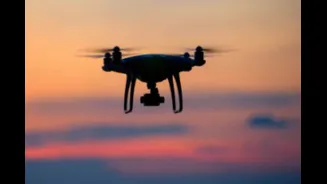What was meant to be a technological milestone in election monitoring turned into airborne chaos in Hyderabad on Tuesday. Six election surveillance drones, deployed for the first time in India to track
voting irregularities, were brought down by unidentified miscreants using kites during the bypoll in Jubilee Hills. The incident left election officials both startled and scrambling for answers.
What do we know about the aerial drama?
A total of 139 licensed drone pilots from Telangana, Andhra Pradesh, and Tamil Nadu were assigned to oversee polling activities. The operation took a dramatic turn when an organised kite-flying tactic was reportedly employed to strike drones mid-air.
Four localities were affected, two drones each in Rahmatnagar and Karmika Nagar, and one each in Madhuranagar and Shaikpet. Each drone, valued at around Rs 2.5 lakh, was disabled mid-flight, prompting swift police deployment to the affected areas.
Each pilot, paid an honorarium of Rs 12,000, was tasked with monitoring a three-kilometre radius around polling stations. The drones, equipped with three batteries and capable of three hours of continuous operation, were linked to a central command centre at GHMC headquarters.
From there, officials monitored over 1,000 hours of live video footage, issuing real-time instructions to field officers.
The drone pilots faced not only airborne sabotage but also intimidation on the ground. In two separate incidents, unidentified individuals allegedly attempted to snatch drones and threatened operators, according to police sources. Despite these setbacks, the drones played a key role in ensuring surveillance continuity throughout the day.
Investigation underway
Authorities have launched a detailed investigation into the coordinated kite attacks and other attempts to disrupt operations. The footage captured before the drones were downed will be scrutinised to identify potential violations and those responsible for the sabotage.
The Hyderabad bypoll has now earned an unusual distinction in India’s electoral history, the first time technology-driven election surveillance was countered by a traditional tactic: kite flying. Investigators are still determining how such precise aerial disruptions were executed so efficiently.















